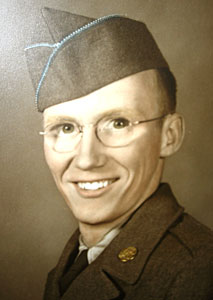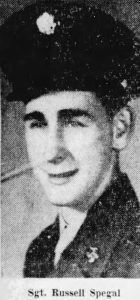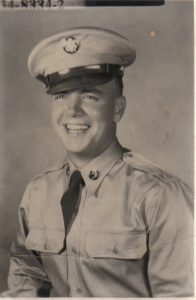William Andrew Dishman from Kentucky, Jefferson county.
Service era: Vietnam
Date of death: Friday, April 17, 1970
Source: National Archives

Promote & Preserve stories of U.S. fallen soldiers/sailors
William Andrew Dishman from Kentucky, Jefferson county.
Service era: Vietnam
Date of death: Friday, April 17, 1970
Source: National Archives
Donald L. Menken, age 21, from Kentucky, Letcher county.
Service era: Korea
Date of death: Wednesday, June 10, 1953
Death details: On February 2, 2022, the Defense POW/MIA Accounting Agency (DPAA) identified the remains of Corporal Donald Louis Menken, missing from the Korean War. Corporal Menken entered the U.S. Army from Kentucky and served with Company K, 3rd Battalion, 15th Infantry Regiment, 3rd Infantry Division. On June 10, 1953, his unit defended “Outpost Harry” near Surang-ni, North Korea. That night, Chinese Communist Forces bombarded Outpost Harry with artillery before attacking the American lines at the outpost directly. While the CCF succeeded in taking the trenches in front of the outpost, U.S. troops prevented them from advancing further and forced their withdrawal a few days later. CPL Menken was killed in action on June 10 while defending Outpost Harry, and his remains could not be recovered at the time of his loss. In August of 1953, a Search and Recovery team recovered two sets of remains from near Outpost Harry. While one set was identified, the other could not be identified and was buried as an unknown at the Tanggok United Nations Cemetery before being moved the the National Memorial Cemetery of the Pacific in Honolulu, Hawaii. In 2019, a family request prompted the disinterment of this unknown set of remains, which were accessioned into the DPAA laboratory for identification. Laboratory analysis and circumstantial evidence established the remains as those of CPL Menken.
Source: National Archives, Defense POW/MIA Accounting Agency
Charles Edward Liford, age 21, from Kentucky, Harlan county.
Service era: Korea
Date of death: Friday, October 24, 1952
Death details: In late October 1952, elements of the U.S. 32nd Infantry Regiment attacked Chinese forces on Hill 598 (often referred to as the Triangle Hill Complex) near Kumhwa, North Korea. Triangle Hill was composed of three high peaks, two of which were nicknamed “Pike’s Peak” and “Jane Russell.” If U.S. troops could push the Chinese off Triangle Hill, the Chinese would have to fall back to the next high defensible position. The initial U.S. assault was effective; however, the Chinese quickly counterattacked, sending wave after wave of troops against the 32nd’s positions on Pike’s Peak and Jane Russell. Chinese forces eventually re-established themselves on Pike’s Peak and U.S. troops were unable to dislodge them. Corporal Charles Edward Liford, who joined the U.S. Army from Kentucky, served with G Company, 2nd Battalion, 32nd Infantry Regiment, 7th Infantry Division. He was reported missing on October 24 when Chinese troops attacked his unit’s defensive position on Hill 598. He was not seen to fall in battle and he was not reported to be a prisoner of war. The area of his loss did not return to the control of U.S. forces, precluding a search for his remains, and the terms of the ceasefire later placed the area inside the Demilitarized Zone. Corporal Liford’s remains were not identified among those returned to U.S. custody after the ceasefire. Today, Corporal Liford is memorialized on the Courts of the Missing at the National Memorial Cemetery of the Pacific.
Source: National Archives, Defense POW/MIA Accounting Agency

John Harison Basham, age 19, from Kentucky, Jefferson county.
Service era: Korea
Date of death: Wednesday, April 25, 1951
Death details: On April 25, 1951, elements of the 24th Infantry Division, including the 21st Infantry Regiment and the 5th Regimental Combat Team, which was attached to the division at the time, were dug into positions north of Seoul, South Korea, where massive Chinese Communist Forces (CCF) had regrouped after their previous attempts to penetrate the valley areas east of Seoul. The CCF launched a renewed offensive against these positions, and despite fierce resistance, could not be stopped. Full enemy divisions were committed in succession, passing around or through their own lines to engage severely outnumbered friendly forces. For several miles, a withdrawal by stages unfolded. Artillery and tanks covered movement after movement, using slight rises in terrain to their full defensive value. The U.S. units suffered heavy casualties and had many men captured during these successive rear guard actions. Private First Class John Harrison Basham entered the U.S. Army from Kentucky and was a member of I Company, 3rd Battalion, 19th Infantry Regiment, 24th Infantry Division. On April 25, he went missing in action during these withdrawals. He was never reported to be a prisoner of war, and his remains were not identified among those returned to U.S. custody following the ceasefire. Today, Private First Class Basham is memorialized on the Courts of the Missing at the National Memorial Cemetery of the Pacific.
Source: National Archives, Defense POW/MIA Accounting Agency
William Franklin McDaniel, age 20, from Kentucky, McCracken county.
Service era: Korea
Date of death: Wednesday, November 29, 1950
Death details: On November 29, 1950, men from Company G of the U.S. 1st Marine Regiment, MP Company and Tank Company, 1st Marine Division, Company B and elements of Company D of the 31st Infantry Regiment, Headquarters Company of the X Corps, and Royal Marines from Number 41 Independent Commando Battalion were sent north from Koto-ri to open the main supply route to Hagaru-ri and resupply and reinforce Allied troops that had been surrounded near the Chosin Reservoir. The group, known as Task Force Drysdale, set out with tanks and other vehicles in the lead and rear, and initially only met light resistance from Chinese Communist Forces (CCF). As attacks increased in ferocity, the group became fragmented as the CCF managed to establish road blocks that further split the task force. Soon, the CCF blew a bridge and halted the convoy altogether. The Royal Marines and most of Company G were north of the bridge at this time and were able to continue to Hagaru-ri. Near the south end of the convoy, a destroyed truck blocked the road. The tanks and troops south of the destroyed truck fought as long as possible before ultimately returning to Koto-ri on November 30. The men between the blown bridge and the destroyed truck, however, were trapped, and subjected to several mortar barrages before CCF moved into hand-to-hand combat range. Fighting raged there until the morning of November 30, when the survivors were forced to surrender. Over 300 troops were wounded, captured, or died during the action. Sergeant William Franklin McDaniel entered the U.S. Army from Kentucky and served in Headquarters Company, X Corps. He went missing during Task Force Drysdale’s drive from Koto-ri to Hagaru-ri, though specific details regarding his loss are unknown. No one saw him fall, and there is no evidence suggesting he was ever alive in enemy hands. Attempts following the war to recover or identify his remains were unsuccessful. Today, Sergeant McDaniel is memorialized on the Courts of the Missing at the National Memorial Cemetery of the Pacific.
Source: National Archives, Defense POW/MIA Accounting Agency

Russell Lee Spegal, age 20, from Kentucky, Grant county.
Service era: Korea
Date of death: Thursday, November 2, 1950
Death details: During the last week of October 1950, Republic of Korea (ROK) Army forces under the control of the U.S. Eighth Army were advancing deep in North Korean territory, approaching the Yalu River on the Chinese-Korean border. Chinese Communist Forces (CCF) struck back in a surprise attack, engaging the ROK 1st and 6th Divisions near Unsan, some sixty miles north of Pyongyang. The U.S. 1st Cavalry Division, with the 8th Cavalry Regiment in the lead, was rushed forward to reinforce the ROK units in the Unsan area. On November 1, the regiment’s 1st Battalion took up positions north of Unsan, while the 2nd Battalion moved to guard the Nammyon River valley west of town, and the 3rd Battalion was placed in reserve at the valley’s southern end. Sergeant Russell Lee Spegal joined the U.S. Army from Kentucky and was a member of Company C, 1st Battalion, 8th Cavalry Regiment, 1st Cavalry Division. On November 1, 1950, Company C was in defensive positions with the 1st Battalion near Unsan when it came under heavy enemy attack and was forced to withdraw. The company faced continued enemy attacks during the withdrawal, and it was during this fighting that SGT Spegal went missing, though specific details regarding his loss are unknown. He was never reported as a prisoner of war, and his remains were not identified among those returned to the U.S. following the war. Today, Sergeant Spegal is memorialized on the Courts of the Missing at the National Memorial Cemetery of the Pacific.
Source: National Archives, Defense POW/MIA Accounting Agency, Kentucky Post and Times Star (1954)
John Edward McCabe, age 22, from Kentucky, Mason county.
Parents: James McCabe
Service era: Korea
Date of death: Thursday, November 2, 1950
Death details: During the last week of October 1950, Republic of Korea (ROK) Army forces under the control of the U.S. Eighth Army were advancing deep in North Korean territory, approaching the Yalu River on the Chinese-Korean border. Chinese Communist Forces (CCF) struck back in a surprise attack, engaging the ROK 1st and 6th Divisions near Unsan, some sixty miles north of Pyongyang. The U.S. 1st Cavalry Division, with the 8th Cavalry Regiment in the lead, was rushed forward to reinforce the ROK units in the Unsan area. On November 1, the regiment’s 1st Battalion took up positions north of Unsan, while the 2nd Battalion moved to guard the Nammyon River valley west of town, and the 3rd Battalion was placed in reserve at the valley’s southern end. Private First Class John Edward McCabe joined the U.S. Army from Kentucky and was a member of Company M, 3rd Battalion, 8th Cavalry Regiment, 1st Cavalry Division. On November 2, 1950, Company M was serving as a security unit supporting 8th Cavalry Regiment elements near Unsan when it was hit by an enemy attack and forced to withdraw. Private First Class McCabe was taken as a prisoner of war (POW) at some point during the withdrawal. Repatriated POWs reported that PFC McCabe died on November 13, 1950; his remains were not identified among those returned to the U.S. following the war. Today, Private First Class McCabe is memorialized on the Courts of the Missing at the National Memorial Cemetery of the Pacific.
Source: National Archives, Defense POW/MIA Accounting Agency, Kentucky Post (1950)

Henry Albert Lee, age 20, from Kentucky, Kenton county.
Service era: Korea
Date of death: Thursday, November 2, 1950
Death details: During the last week of October 1950, Republic of Korea (ROK) Army forces under the control of the U.S. Eighth Army were advancing deep in North Korean territory, approaching the Yalu River on the Chinese-Korean border. Chinese Communist Forces (CCF) struck back in a surprise attack, engaging the ROK 1st and 6th Divisions near Unsan, some sixty miles north of Pyongyang. The U.S. 1st Cavalry Division, with the 8th Cavalry Regiment in the lead, was rushed forward to reinforce the ROK units in the Unsan area. On November 1, the regiment’s 1st Battalion took up positions north of Unsan, while the 2nd Battalion moved to guard the Nammyon River valley west of town, and the 3rd Battalion was placed in reserve at the valley’s southern end. Corporal Henry Albert Lee joined the U.S. Army from Kentucky and served with the Headquarters Company of the 2nd Battalion, 8th Cavalry Regiment, 1st Cavalry Division. On November 2, 1950, Headquarters Company was near Unsan with the 2nd Battalion when it came under heavy attacks and received orders to withdraw. Eventually surrounded and besieged by CCF, some company members became trapped and dug inside foxholes or behind bunkers. Corporal Lee was lost during the withdrawal from the Unsan area, although the exact circumstances surrounding his loss are unknown. He was never reported as a prisoner of war nor was he identified among the remains returned to U.S. custody after the ceasefire. Today, Corporal Lee is memorialized on the Courts of the Missing at the National Memorial Cemetery of the Pacific.
Source: National Archives, Defense POW/MIA Accounting Agency
James Thomas Higgins, age 20, from Kentucky, Harlan county.
Parents: Samuel E. Higgins
Service era: Korea
Date of death: Wednesday, November 1, 1950
Death details: On May 2, 2000, Joint Task Force-Full Accounting (JTF-FA, now DPAA) identified the remains of Sergeant James Thomas Higgins, missing from the Korean War. Sergeant Higgins, who entered the U.S. Army from Kentucky, served with Company E, 2nd Battalion, 8th Cavalry Regiment, 1st Cavalry Division. On November 1, 1950, SGT Higgins was killed by a grenade explosion during combat with Chinese Communist Forces in Pyongan Province, North Korea. His remains were buried near the battlefield where he fell, but could not be recovered at the time. In 1997, U.S. analysts traveled to Pyong-an Province and excavated a burial site correlating to an area where the 8th Cavalry Regiment fought during the Korean War. The site yielded the commingled remains of four individuals along with military and other artifacts, and U.S. forensic analysts eventually identified SGT Higgins from among these remains.
Source: National Archives, Defense POW/MIA Accounting Agency, Courier Journal (1950)
Ardell Nation Neal, age 23, from Kentucky, Ohio county.
Service era: Korea
Date of death: Wednesday, November 1, 1950
Death details: During the last week of October 1950, Republic of Korea (ROK) Army forces under the control of the U.S. Eighth Army were advancing deep in North Korean territory, approaching the Yalu River on the Chinese-Korean border. Chinese Communist Forces (CCF) struck back in a surprise attack, engaging the ROK 1st and 6th Divisions near Unsan, some sixty miles north of Pyongyang. The U.S. 1st Cavalry Division, with the 8th Cavalry Regiment in the lead, was rushed forward to reinforce the ROK units in the Unsan area. On November 1, the regiment’s 1st Battalion took up positions north of Unsan, while the 2nd Battalion moved to guard the Nammyon River valley west of town, and the 3rd Battalion was placed in reserve at the valley’s southern end. Corporal Ardell National Neal joined the U.S. Army from Kentucky and was a member of Company G of the 2nd Battalion, 8th Cavalry Regiment, 1st Cavalry Division. On November 1, 1950, Company G was conducting defensive operations with the 2nd Battalion near Unsan when it came under an intense rocket and mortar attack and was forced to withdraw. Corporal Neal went missing during this action, though circumstances surrounding his loss are unknown. He was never reported as a prisoner of war, and his remains were not identified among those returned to the U.S. following the war. Today, Corporal Neal is memorialized on the Courts of the Missing at the National Memorial Cemetery of the Pacific.
Source: National Archives, Defense POW/MIA Accounting Agency, Owensboro Messenger Inquirer (1955)